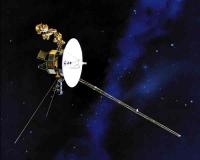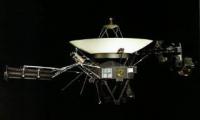Nature is reporting that the two Voyager missions — recently discussed here as our first active probes of the interstellar medium, if they live long enough to cross the heliospheric boundary — may be terminated in October. The decision is not yet final, and there is always the hope that it will spur enough reaction among space scientists and others to force a reprieve.
But if these missions end (along with six others, including Ulysses), the loss to science would be severe. Voyager 1 is the fastest man-made object, now leaving the Sun behind at over 17 kilometers per second, at a current distance of approximately 94 AU (14 billion kilometers from Earth). Voyager 2 is roughly 76 AU out. Both spacecraft should be able to continue transmitting until 2020 or later.
 At $4.2 million per year, the Voyager program catches NASA’s eye as the agency ponders budgetary cutbacks. But to shut down two operational spacecraft as they approach the interstellar medium for the first time in history is unthinkable.
At $4.2 million per year, the Voyager program catches NASA’s eye as the agency ponders budgetary cutbacks. But to shut down two operational spacecraft as they approach the interstellar medium for the first time in history is unthinkable.
Robert Forward told a budgetary tale with some resemblance to this one in his 1990 novel Rocheworld. A human crew has been sent to Barnard’s Star, on a spacecraft powered by a laser sail. Forty years out, the question for Earth’s politicians becomes whether or not to finance the enormous laser installation that must be fired to allow the vehicle’s sail system to decelerate upon arrival (how Forward set up deceleration by laser beam from Earth is so ingenious that it deserves, and will get, a separate entry in the near future). Forward also solved the political problem, but then, he knew a thing or two about how committees work.
No one can discount the fiscal realities, but we have to hope that a formal scientific review of these proposed funding shutdowns will be initiated, as has been done in the past when issues of mission termination have arisen. That review should take into account not only the scientific value of the data both Voyagers can provide as they approach and cross the ‘termination shock’ and the heliopause, but also the less tangible philsophical return from the exploration of utterly uncharted territory. Our knowledge of history should remind us that pushing back boundaries is a human imperative.
Centauri Dreams has made the case that robotic exploration of the outer Solar System will lead to interstellar probes that will examine the Oort Cloud and, eventually, the nearest stars. The technologies for making such probes a reality — and the issues they raise — are on display in microcosm in the Voyager story. These two spacecraft have demonstrated long-life electronics and communication over vast distances. They have taught us much about how to improve in both areas, and how to create robotic systems that can assume greater spacecraft autonomy, as witness Cassini. On the propulsion front, we have learned to harness gravity ‘slingshot’ maneuvers around planets, and now we have flown ion engines in space. We are not far from flight testing a solar sail.
 But even as we do these things, we have two functional probes pushing ever deeper into a region no instruments have ever seen. To abandon these forerunner craft, 10000 days out from Earth and still alive, would be to fall victim to the worst kind of short-term thinking. It would be to turn our backs on a gift to the human future.
But even as we do these things, we have two functional probes pushing ever deeper into a region no instruments have ever seen. To abandon these forerunner craft, 10000 days out from Earth and still alive, would be to fall victim to the worst kind of short-term thinking. It would be to turn our backs on a gift to the human future.
The Nature article is “NASA Funding Shortfall Means Journey’s End for Voyager Probes,” in the issue of March 9. Also see “Space Science: NASA Plans to Turn Off Several Satellites” in Science 307, p. 1541.

